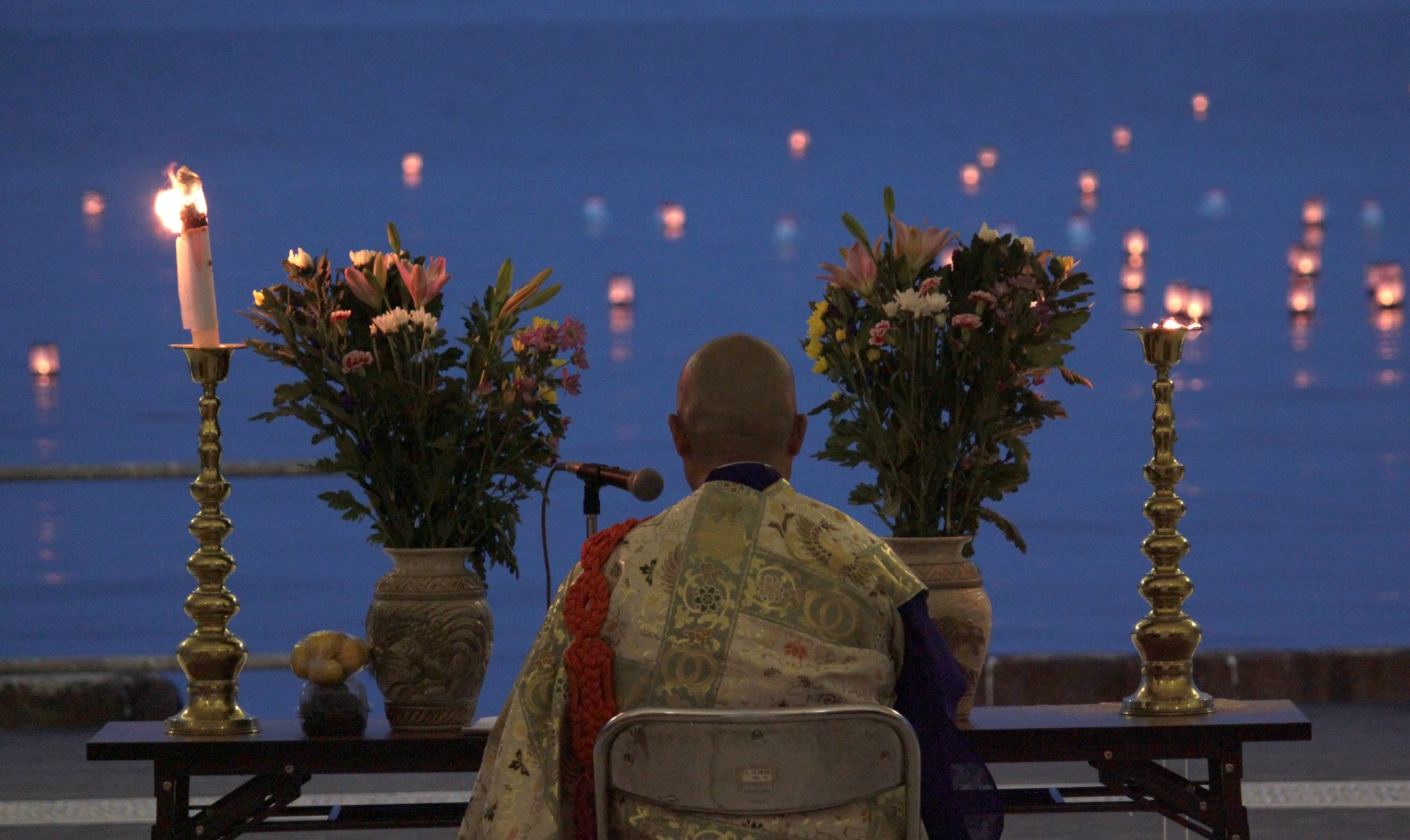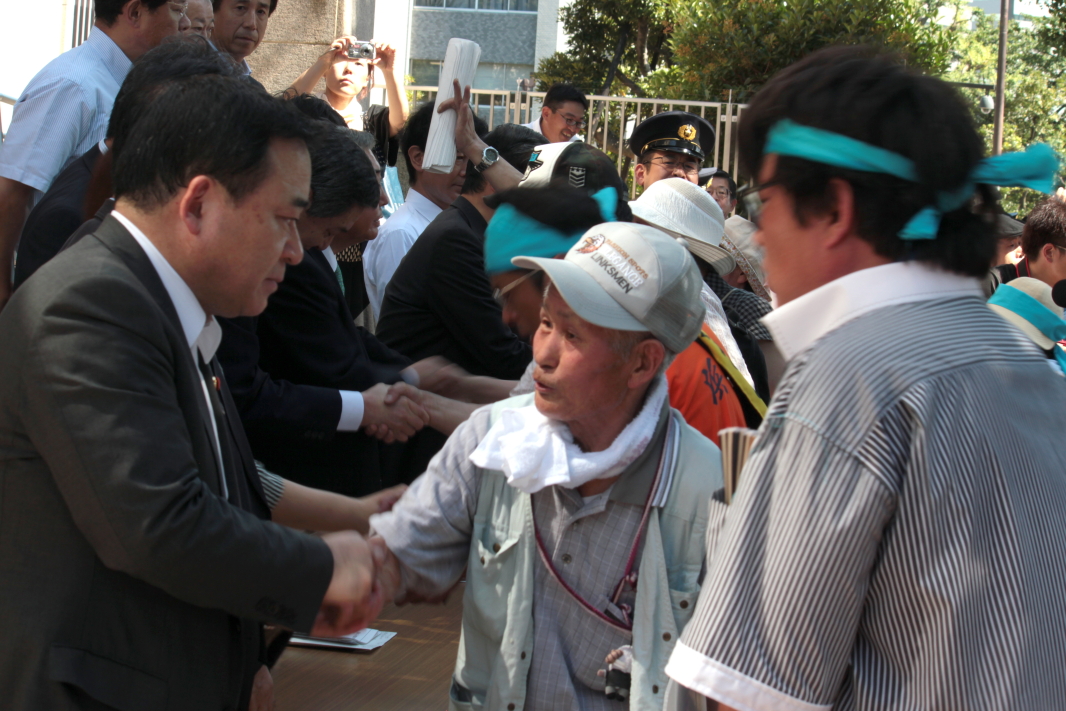-
 Yoshizawa at evacuated Namie's city hall-in-exile in Nihonmatsu, awaiting the results of his full-body radiation scan.
Yoshizawa at evacuated Namie's city hall-in-exile in Nihonmatsu, awaiting the results of his full-body radiation scan. -
 Yoshizawa displays the results of his radiation scan, which indicate he's been exposed to only .3 millisieverts since March. He's dubious of this figure, considering he was within earshot of the reactor explosion and has been returning to the evacuation zone weekly to care for his cows.
Yoshizawa displays the results of his radiation scan, which indicate he's been exposed to only .3 millisieverts since March. He's dubious of this figure, considering he was within earshot of the reactor explosion and has been returning to the evacuation zone weekly to care for his cows. -

-

-
 Iwaki hula girls perform at Nihonmatsu Candle Festival.
Iwaki hula girls perform at Nihonmatsu Candle Festival. -
 Giant dragonfly in Nihonmatsu castle park.
Giant dragonfly in Nihonmatsu castle park. -
 Bug in a well at Nihonmatsu castle.
Bug in a well at Nihonmatsu castle. -
 Yoshizawa and Murata throw a barbecue to celebrate receiving half of their substantial compensation claim from Tokyo Electric Power Company for losses due to radioactive contamination of their cattle ranch.
Yoshizawa and Murata throw a barbecue to celebrate receiving half of their substantial compensation claim from Tokyo Electric Power Company for losses due to radioactive contamination of their cattle ranch. -
 A mother feeds her son at Yoshizawa's compensation party.
A mother feeds her son at Yoshizawa's compensation party. -
 Revelers were eating this Wagyu beef raw at Yoshizawa's compensation party.
Revelers were eating this Wagyu beef raw at Yoshizawa's compensation party. -
 When the town of Towa was absorbed into Nihonmatsu City, they formed a nonprofit organization to preserve local culture and farming practices. A transplant from Osaka, Ebisawa is director of the group. He's been resurrecting Towa's ancient mulberry industry, and now he's running an active radiation measurement program.
When the town of Towa was absorbed into Nihonmatsu City, they formed a nonprofit organization to preserve local culture and farming practices. A transplant from Osaka, Ebisawa is director of the group. He's been resurrecting Towa's ancient mulberry industry, and now he's running an active radiation measurement program. -
 Ebisawa demonstrates Towa's "healthy food" independent organic certification.
Ebisawa demonstrates Towa's "healthy food" independent organic certification. -
 A diorama in Ebisawa's grocery store depicts traditional fertilizer production.
A diorama in Ebisawa's grocery store depicts traditional fertilizer production.
“Don’t forget us,” cry Fukushima nuclear evacuees
Tens of thousands of people evacuated due to radioactive fallout from the Fukushima Daiichi Nuclear Power Plant are living in shelters and storage unit-style temporary housing. Nearly 100 have committed suicide. Many relocation centers are in highly radioactive areas—sometimes higher than the towns that were evacuated.
On July 12, the evacuees held their first protest in Tokyo, marching from Hibiya Park to parliament, calling for their land to be decontaminated, and for better resettlement conditions. “Don’t forget us” was their rallying cry.
Into the evacuation zone
-
 Hidden under a tarp, wedged between 50-gallon sacks of steaming bean sprouts on a flatbed trailer, we passed unnoticed through the checkpoint into the 30km evacuation zone around the crippled Fukushima Daiichi Nuclear Power Plant. Permits to enter the zone are closely guarded and the review process is slow, so we stowed away with the evacuated dairy farmer Yoshizawa as he made his weekly trip to feed his 300 irradiated cows, which he's keeping alive in defiance of a government order.
Hidden under a tarp, wedged between 50-gallon sacks of steaming bean sprouts on a flatbed trailer, we passed unnoticed through the checkpoint into the 30km evacuation zone around the crippled Fukushima Daiichi Nuclear Power Plant. Permits to enter the zone are closely guarded and the review process is slow, so we stowed away with the evacuated dairy farmer Yoshizawa as he made his weekly trip to feed his 300 irradiated cows, which he's keeping alive in defiance of a government order. -
 This field in Minami-Soma is still littered with boats, four months after the tsunami.
This field in Minami-Soma is still littered with boats, four months after the tsunami. -
 Yoshizawa painted "save them or die trying" on the roof of the barn, the shovel of the back hoe that blocks the road to the ranch, and on signposts all along the road.
Yoshizawa painted "save them or die trying" on the roof of the barn, the shovel of the back hoe that blocks the road to the ranch, and on signposts all along the road. -

-
 Junko Kajino interviews Yoshizawa at his ranch. The rain suits we bought as a cheaper alternative to tyvek safety suits were not a good idea in the heat and sun. We were pouring with hot sweat within minutes.
Junko Kajino interviews Yoshizawa at his ranch. The rain suits we bought as a cheaper alternative to tyvek safety suits were not a good idea in the heat and sun. We were pouring with hot sweat within minutes. -
 The cows were intimidated by my camera shoulder mount at first, but they became friendly very quickly.
The cows were intimidated by my camera shoulder mount at first, but they became friendly very quickly. -

-
 It was 2 microsieverts per hour at this ice cream stand on the way to the evacuation zone.
It was 2 microsieverts per hour at this ice cream stand on the way to the evacuation zone.
Evacuated farmer Yoshizawa wants to stand up to Japanese government and nuclear power company
After the March 11 earthquake and tsunami, Yoshizawa cared for his 300 dairy cows without water or electricity. He could hear the explosions as the Fukushima Daiichi Nuclear Power Plant, 14 km away.
After days of heavy radiation exposure, Yoshizawa was evacuated with the rest of Namie on March 17. He spraypainted “save them or die trying” on the roof of the barn, and went to Tokyo. He talked his way in to see the chairman of Tokyo Electric Power Company. Both men cried as Yoshizawa begged the chairman to do something to stop the disaster.
Yoshizawa slept outside in Tokyo for a week, keeping vigil and waiting to see government ministers, calling on them for action. Now he travels Japan in his speaker van, proclaiming his refusal of a government order to kill his 300 cows.
Uncanny Terrain is a documentary about organic farmers facing Japan’s nuclear crisis, and an online community fostering dialogue on food safety, sustainable agriculture, alternative energy and disaster response. Please keep the conversation going by making a donation.












